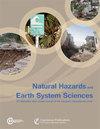带锁定段滑坡的三维稳定性模拟分析:中国西南茂县梯子草滑坡案例研究
IF 4.2
2区 地球科学
Q1 GEOSCIENCES, MULTIDISCIPLINARY
引用次数: 0
摘要
摘要岩桥又称滑坡中的锁定块,会影响滑坡的三维(3D)稳定性和变形模式。然而,由于岩桥的变形不连续,在三维滑坡中使用连续网格模型模拟岩桥总是很困难。位于中国西南部茂县的梯子草滑坡是一个典型的滑坡,其岩体体积约为 1388.2 × 104 m3,是一个超大型的锁定段。为了探索更好的岩桥模型来模拟梯子草滑坡的三维稳定性和变形,本研究在 FLAC3D 程序中引入了三种岩桥模型,包括完整岩体模型(IRMM)、詹宁斯模型(JM)和高强度参数接触面模型(CSM-HSP)。CSM-HSP 模型最终被用于 FLAC3D 程序,以获得滑坡的三维变形特征。此外,还使用 GeoStudio 程序分析了 Tizicao 滑坡的二维(2D)稳定性。模拟结果表明,Tizicao 滑坡在当前条件下总体上是稳定的,原因是其南侧前沿存在锁定段。这一推断与实地变形和监测数据相吻合。根据二维和三维稳定性对比发现,滑坡的总体稳定性和局部变形受到锁定段的影响。锁定比与安全系数(Fos)之间存在线性关系,这适用于各有一个锁定段的滑坡的二维稳定性分析,而存在一个近似二次抛物线,适用于滑坡的三维稳定性分析。最后,本研究分析了三维 Fos 随锁定比、锁定块强度参数和滑动面变化的规律。此外,研究还探讨了三种岩桥模型在模拟带有锁定段的滑坡三维稳定性方面的优缺点。本文章由计算机程序翻译,如有差异,请以英文原文为准。
Simulation analysis of 3D stability of a landslide with a locking segment: a case study of the Tizicao landslide in Maoxian County, southwest China
Abstract. Rock bridges, also known as locking masses in landslides, affect the three-dimensional (3D) stability and deformation patterns of landslides. However, it is always difficult to simulate rock bridges with continuous grid models in 3D landslides due to their discontinuous deformations. Tizicao landslide, located in Maoxian County, southwest China, is a typical landslide with a super-large rock mass volume of about 1388.2 × 104 m3 and a locking segment. To explore a better rock bridge model used to simulate 3D stability and deformations of the Tizicao landslide, this study introduced three rock bridge models into the FLAC3D program, including the intact rock mass model (IRMM), the Jennings model (JM), and the contact surface model with high strength parameters (CSM-HSP). The CSM-HSP model was eventually used in the FLAC3D program to obtain the 3D deformation characteristics of the landslide. In addition, the two-dimensional (2D) stability of the Tizicao landslide was analyzed using the GeoStudio program. The simulation results indicate that the Tizicao landslide is generally stable under current conditions owing to the existence of the locking segment in its southern front. This inference is consistent with the field deformation and monitoring data. It was found that the general stability and local deformations of the landslide are influenced by the locking segment according to the comparison between the 2D and 3D stability. There was a linear relationship between the locking ratio and the factor of safety (Fos), which applied to the 2D stability analysis of the landslides with a locking segment each, while there existed an approximate quadratic parabola suitable for the 3D stability of the landslides. Finally, this study analyzed the laws of the 3D Fos varying with the locking ratio and strength parameters of the locking masses and the sliding surface. Furthermore, it explored the advantages and disadvantages of the three rock bridge models in the simulation of the 3D stability of landslides with a locking segment.
求助全文
通过发布文献求助,成功后即可免费获取论文全文。
去求助
来源期刊
CiteScore
7.60
自引率
6.50%
发文量
192
审稿时长
3.8 months
期刊介绍:
Natural Hazards and Earth System Sciences (NHESS) is an interdisciplinary and international journal dedicated to the public discussion and open-access publication of high-quality studies and original research on natural hazards and their consequences. Embracing a holistic Earth system science approach, NHESS serves a wide and diverse community of research scientists, practitioners, and decision makers concerned with detection of natural hazards, monitoring and modelling, vulnerability and risk assessment, and the design and implementation of mitigation and adaptation strategies, including economical, societal, and educational aspects.

 求助内容:
求助内容: 应助结果提醒方式:
应助结果提醒方式:


